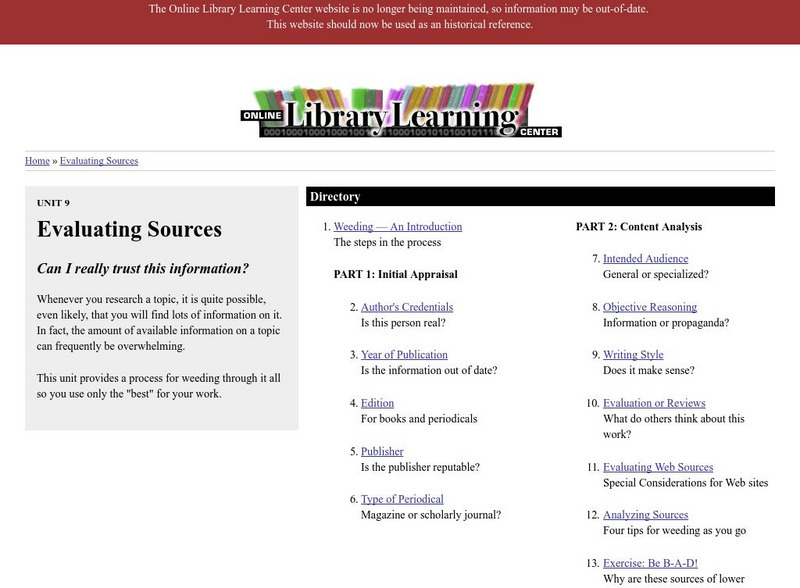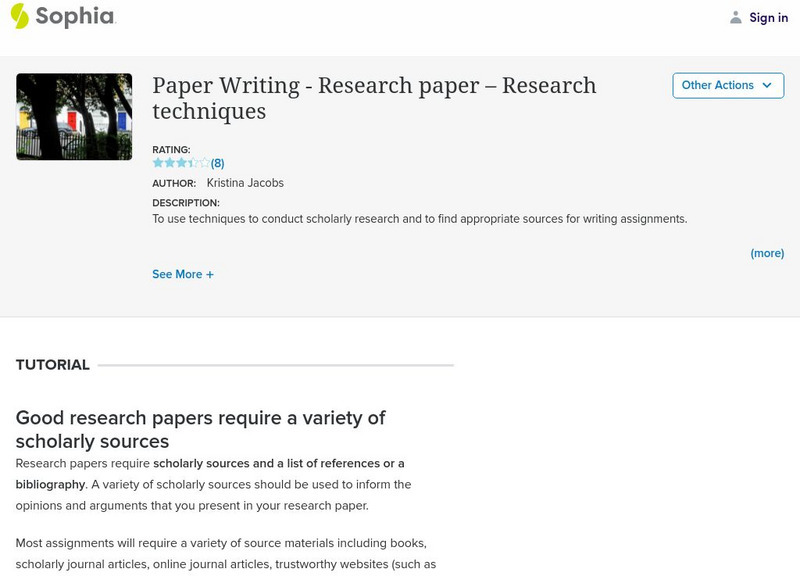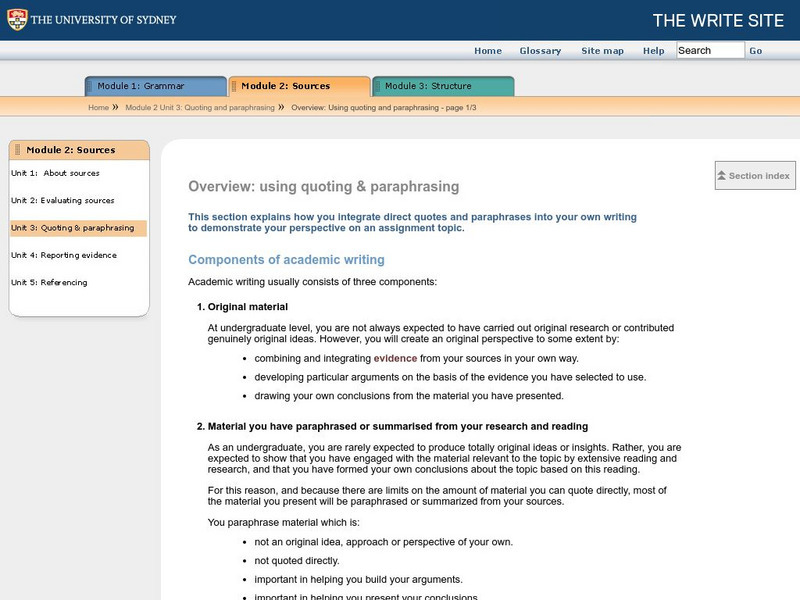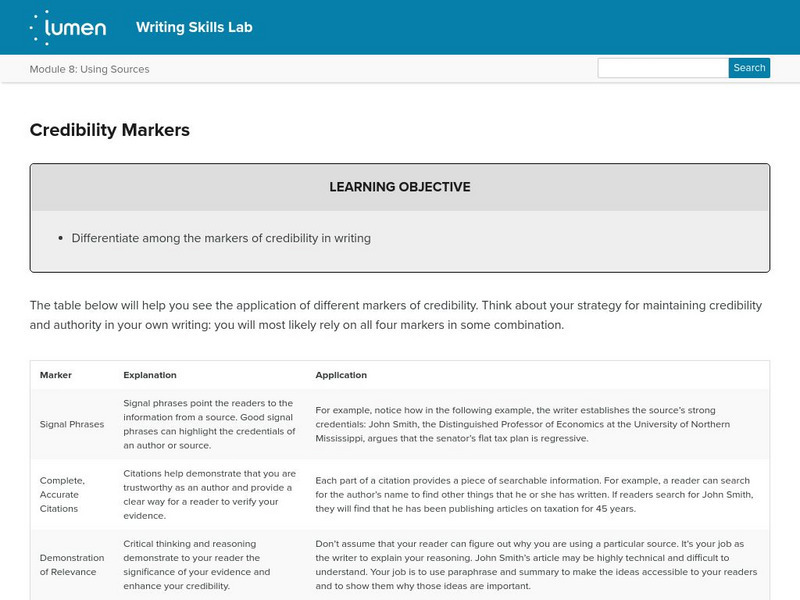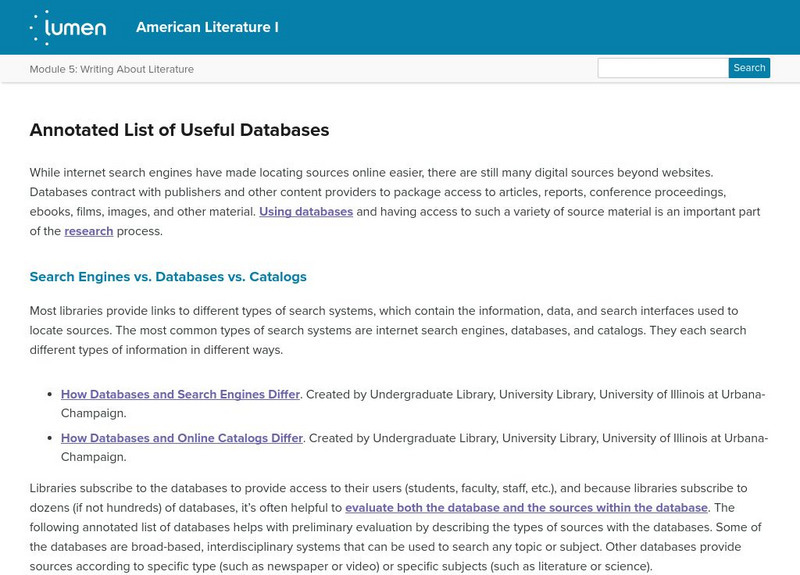Grammarly
Grammarly Handbook: Asa (American Sociological Association)
This page explains the basics of the ASA citation style including in-text citations and the basics of bibliographic citations with examples. A link is provided to the ASA website for more information.
University of Maryland
University of Maryland Libraries: Preparing an Annotated Bibliography
This step-by-step guide explains the purpose and the procedure for creating annotated bibliographies. Sample entries are included.
Other
Online Library Learning Center: Evaluating Sources
Use this "Weed and feed," approach to get only the best resources for your research project.
Other
Awesome Library
Awesome Library's searchable database is full of resources in all subject areas. It also provides information to parents, students, teachers, principal, family, and community.
Sophia Learning
Sophia: Wrangling Research, Apa Style
An overview of the purpose and rules of APA guidelines. Includes a slideshow tutorial and video on formatting the document in MS Word 2007. Additional resources are also listed. [0:32]
Sophia Learning
Sophia: In Text Citations: Lesson 6
This lesson introduces in-text citations and how to embed them in text. It is 6 of 7 in the series titled "In-Text Citations." W.9-10.8 Sources
Cambridge Rindge & Latin School
Cambridge Rindge & Latin School: Making Source Cards
A great resource for putting together all of a student's possible sources onto note cards for later using in citing.
Online Writing Lab at Purdue University
Purdue University Owl: Types of Sources
A list and explanation of different types of print and online sources. W.11-12.8 Sources/Integrate/Cite
Sophia Learning
Sophia: Paper Writing: Research Paper: Research Techniques
This site presents writers with information about appropriate resources to use when writing research papers and useful tips on how to find these resources. Students can read through a vocabulary section to learn the definitions of common...
University of Toronto (Canada)
University of Toronto: Standard Documentation Formats
Documenting Internet resources is becoming standardized. You'll find some of the basics here, plus links to more detailed guidelines now included in respected academic style guides. L.9-10.3a Standard Format, W.11-12.6 Technology,...
Joe Landsberger
Study Guides & Strategies: Elements of a Research Paper
All the basics of writing the research paper are presented here very succinctly. Links to more in-depth looks at various steps are provided.
University of Sydney (Australia)
The Write Site: Overview: Using Quoting & Paraphrasing
This learning module explains the components of academic writing. The module includes the following topics: original material, paraphrased content, summarized information, and direct quotations.
Lumen Learning
Lumen: Evaluating Sources: Introduction to Types of Sources
This is an introduction to evaluating sources and the types of sources available.
Lumen Learning
Lumen: Evaluating Sources: Scholarly vs. Non Scholarly Sources
This instructional activity focuses on types of sources including scholarly vs. non-scholarly sources and print, online, and multimedia.
Lumen Learning
Lumen: Using Sources: Mla Works Cited
This activity focuses on creating a Works Cited page using the MLA format including page numbers, title, spacing, alphabetical order, and hanging indents. An example is provided. Click the Next button at the bottom right for detailed "in...
Lumen Learning
Lumen: Using Sources: Using Online Citation and Reference Tools
This lesson focuses on using online citation tools and being aware that they make mistakes that must be corrected. W.9-10.8 Sources
Lumen Learning
Lumen: Using Sources: Credibility Markers
This lesson focuses on strategies for maintaining credibility and authority in your writing. It also provides a table of different types of credibility markers, an explanation, and the application for each. SL.9-10.2 eval & integrate...
Lumen Learning
Lumen: Using Sources: Putting It Together: Using Sources
This is a summary of the lessons on integrating credible sources using paraphrase, summary, and quotations and citing sources. Click on the Next button on the bottom right to learn about Why It Matters: Multimodality; you will have the...
Lumen Learning
Lumen: Annotated List of Useful Databases
This is an annotated list of useful databases including the difference between search engines and databases and between databases and catalogs, broad-based databases, source-type databases, and subject-type databases.
Lumen Learning
Lumen: Finding and Evaluating Research Sources
This lesson focuses on how to find, evaluate, and use primary and secondary sources using printed and online sources. It provides practice writing activities such as examining the same topic through primary and secondary sources and...
Indiana University
Indiana University: Plagiarism
Uses examples to explain the right and wrong way to use reference material. Shows how a rewrite can still be plagiarism. Briefly discusses common knowledge and paraphrasing.
Wisc-Online
Wisc Online: Identifying Acceptable Paraphrases
This learning module defines paraphrasing and discusses how to paraphase, and then they identify acceptable paraphrases of source material.
W. W. Norton
W. W. Norton & Company: Lit Web: Types and Functions of Secondary Sources
Information about secondary sources as they are used when writing a research essay.
Library of Congress
Loc: How to Cite Digitized Primary Sources
Learn from the Library of Congress how to correctly cite the many electronic resources available in their collection. Films, legal documents, photographs, maps, sound recordings and other unusual cases are covered. Be sure you click on...



